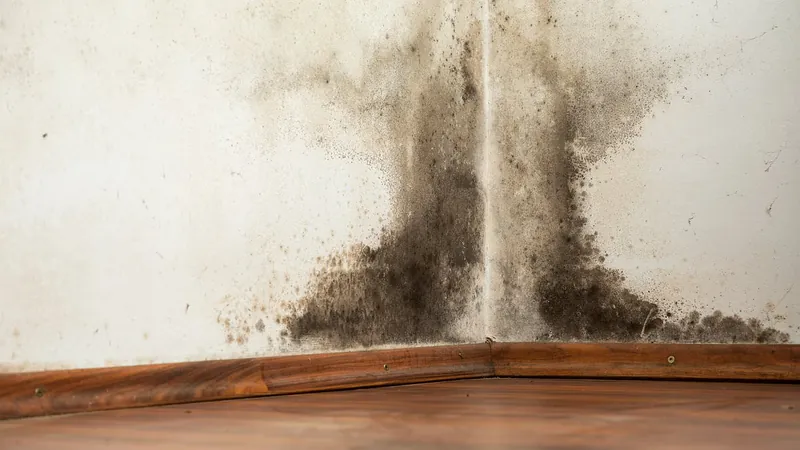
Mold in Your Home: Understanding the Colors That Could Threaten Your Health
2024-11-22
Author: Ming
Mold in Your Home: Understanding the Colors That Could Threaten Your Health
Mold is a common sight in many households, often creeping into our kitchens or bathrooms. While a few small patches may not cause immediate alarm, it’s essential to understand the implications of mold presence within your living spaces. Here’s what you need to know about different types of mold, their potential threats, and how to handle them.
When Should You Worry About Mold?
Most people encounter mold at some point, but experts advise caution. Small patches can usually be cleaned without serious health risks; however, Dr. Nik Money, a distinguished fungal microbiologist, warns homeowners to be concerned if mold covers an area larger than a pizza box—approximately one square foot. Such extensive mold can significantly compromise indoor air quality, releasing numerous spores that can be inhaled, potentially causing respiratory issues and other health problems.
Shocking statistics reveal that mold infestations are rampant in the U.S., with over 70% of homes affected. Alarmingly, around 45 million homes have unhealthy mold levels. Mold is not just a personal issue; schools are also at risk, with 30% showing signs of roof issues that can lead to mold growth.
Inhaling mold spores has been linked to respiratory ailments, cognitive difficulties, and even depression. Particularly concerning is mold found in air conditioning systems, which can spread spores throughout the home. Dr. Money highlighted tragic instances in the UK where exposure to mold has resulted in severe health consequences, including death.
Understanding Mold Colors and Their Risks
Mold comes in various colors, each type presenting its unique risks. Here's a breakdown:
- **Black Mold**: Often referred to as toxic mold, it can grow on damp surfaces like walls and is considered one of the most dangerous types due to its connection to health issues, especially in children. Dr. Money points out that although black mold can be sticky and less airborne than other types, significant coverage can still lead to serious health problems.
- **Blue and Green Mold**: Commonly found indoors, blue mold (Penicillium) and green mold (mycelium fungus) are frequently found on food items such as bread or spoiled produce. While Penicillium is safe in certain foods like cheese, it's crucial to discard contaminated items and clean up any mold growth—both can release spores that linger in the air and impact respiratory health.
- **Pink Mold**: Often seen in bathrooms, pink mold is actually a type of bacteria known as Serratia. This bacteria can thrive in moist environments and, while usually harmless, it can lead to infections, particularly for those with weakened immune systems.
- **Yellow and Orange Mold**: These colors are typically due to molds such as Stemphylium and Epicoccum. They thrive on damp materials like paper and can cause allergic reactions when abundant.
- **White Mold**: The most common variety of white mold is Cladosporium, which can grow in damp spaces like attics or basements. While generally not dangerous, this mold can exacerbate asthma and allergy symptoms, making it essential to address.
How to Deal with Mold Safely
If you discover mold in your home, tackling the problem swiftly is crucial. Experts recommend using bleach or dish detergent to scrub surfaces clean, ensuring to dispose of any heavily infested items. A face mask is advised during cleanup to avoid inhaling spores.
Stay informed and vigilant about mold in your home—you never know what colors might be hiding. Ensure regular maintenance of moisture-prone areas, particularly during humid seasons, and consider professional mold remediation for extensive infestations.
By recognizing the risks associated with mold and understanding when to take action, you can safeguard your health and maintain a safer living environment.



 Brasil (PT)
Brasil (PT)
 Canada (EN)
Canada (EN)
 Chile (ES)
Chile (ES)
 España (ES)
España (ES)
 France (FR)
France (FR)
 Hong Kong (EN)
Hong Kong (EN)
 Italia (IT)
Italia (IT)
 日本 (JA)
日本 (JA)
 Magyarország (HU)
Magyarország (HU)
 Norge (NO)
Norge (NO)
 Polska (PL)
Polska (PL)
 Schweiz (DE)
Schweiz (DE)
 Singapore (EN)
Singapore (EN)
 Sverige (SV)
Sverige (SV)
 Suomi (FI)
Suomi (FI)
 Türkiye (TR)
Türkiye (TR)